
USS Paulding (DD-22) was the lead ship of Paulding-class destroyers in the United States Navy. She was named for Rear Admiral Hiram A. Paulding (1797-1878). She was in commission from 1910 to 1919 and saw service in World War I.

The first USS Cummings (DD-44) was a Cassin-class destroyer used by the United States Navy during World War I. She was later transferred to the United States Coast Guard, where she was designated CG-3. She was named for Lieutenant Commander Andrew Boyd Cummings.

The first USS Philip (DD–76) was a Wickes-class destroyer in the United States Navy during World War I, later transferred to the Royal Navy as HMS Lancaster. She was named for John Woodward Philip.

USS Hull (DD-7) was a Hopkins-class destroyer, which was a sub-class of the Bainbridge-class destroyer, in the United States Navy, the second ship named for Commodore Isaac Hull.
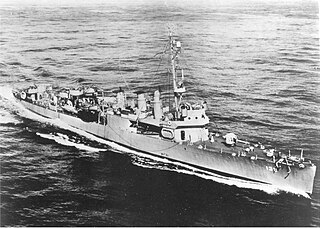
USS Kennison (DD–138) was a Wickes-class destroyer in the United States Navy during World War II, later redesignated AG-83. She was the first ship named for William Kennison.

USS Du Pont (DD–152) was a Wickes-class destroyer in the United States Navy during World War II, later reclassified as AG-80. She was the second ship named for Rear Admiral Samuel Francis Du Pont.

USS Terry (DD-25) was a modified Paulding-class destroyer in the United States Navy during World War I, and later in the United States Coast Guard, designated CG-19. She was the first ship named for Edward A. Terry, and the first ship commanded by future Fleet Admiral and Chief of Naval Operations Ernest J. King.

The second USS Trippe (DD-33) was a Paulding-class destroyer in commission in the United States Navy from 1911 to 1919. She was named for Lieutenant John Trippe. She saw service during World War I.

The first USS Walke (DD-34) was a Paulding-class destroyer in the United States Navy during World War I. She was named for Rear Admiral Henry A. Walke.

The first USS Patterson (DD-36) was a modified Paulding-class destroyer in the United States Navy during World War I and later in the United States Coast Guard, designated as CG-16. She was named for Daniel Patterson.

The first USS Jenkins (DD-42) was a modified Paulding-class destroyer in the United States Navy during World War I. She was named for Rear Admiral Thornton A. Jenkins.

The first USS Cassin (DD-43) was the lead ship of Cassin-class destroyers in the United States Navy during World War I. She was later transferred to the United States Coast Guard, where she was designated CG-1. She was named for Stephen Cassin.
The first USS Duncan (DD-46) was a Cassin-class destroyer in the United States Navy during World War I. She was named for Commander Silas Duncan.
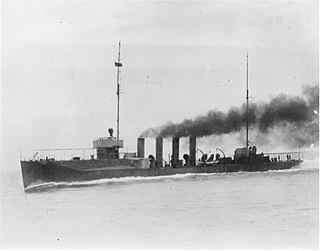
The O'Brien class of destroyers was a class of six ships designed by and built for the United States Navy shortly before the United States entered World War I. The O'Brien class was the third of five classes of destroyers that were known as the "thousand tonners", because they were the first U.S. destroyers over 1,000 long tons (1,016 t) displacement.

USS McDougal was an O'Brien-class destroyer built for the United States Navy prior to the American entry into World War I. The ship was the second U.S. Navy vessel named in honor of David Stockton McDougal, a U.S. Navy officer notable for his leadership during an 1863 battle off Japan while in command of Wyoming.
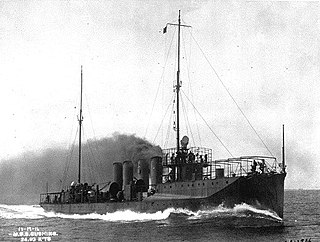
USS Cushing was an O'Brien-class destroyer built for the United States Navy prior to the American entry into World War I. The ship was the second U.S. Navy vessel named in honor of William B. Cushing, a U.S. Navy officer best known for sinking the Confederate ironclad warship CSS Albemarle during the American Civil War.

USS Ericsson was an O'Brien-class destroyer built for the United States Navy prior to the American entry into World War I. The ship was the second U.S. Navy vessel named in honor of John Ericsson, the Swedish-born builder of the ironclad warship USS Monitor during the American Civil War.
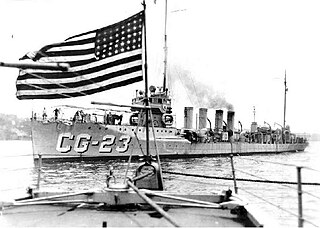
The Tucker class of destroyers was a ship class of six ships designed by and built for the United States Navy shortly before the United States entered World War I. The Tucker class was the fourth of five classes of destroyers that were known as the "thousand tonners", because they were the first U.S. destroyers over 1,000 long tons (1,016 t) displacement.
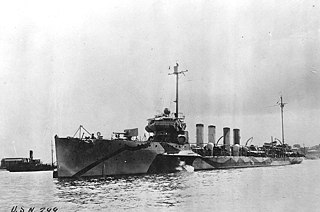
USS Conyngham was a Tucker-class destroyer built for the United States Navy prior to the American entry into World War I. The ship was the first U.S. Navy vessel named for Gustavus Conyngham.

USS Davis (DD-65) was a Sampson-class destroyer in commission in the United States Navy from 1916 to 1922. She saw service during World War I. She was the second Navy ship named for Rear Admiral Charles Henry Davis (1807–1877).



















